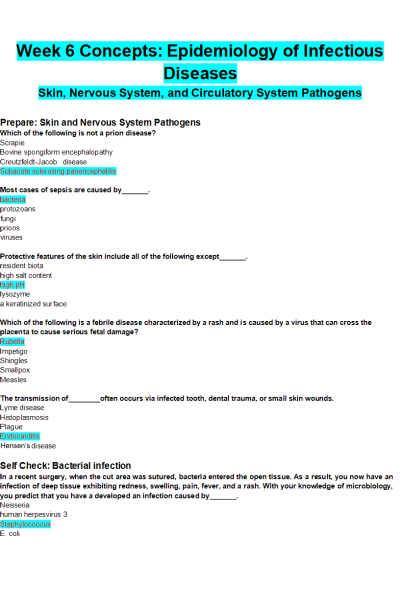BIOS 242 Week 6 Assignment; Concepts; Epidemiology of Infectious Diseases
-
$25.00
| Institution | Chamberlain |
| Contributor | Nikki |
Document Preview
Week 6 Concepts: Epidemiology of Infectious Diseases
Skin, Nervous System, and Circulatory System Pathogens
Prepare: Skin and Nervous System Pathogens
Which of the following is not a prion disease?
Most cases of sepsis are caused by .
Protective features of the skin include all of the following except .
Which of the following is a febrile disease characterized by a rash and is caused by a virus that can cross the placenta to cause serious fetal damage?
The transmission of often occurs via infected tooth, dental trauma, or small skin wounds.
Self Check: Bacterial infection
In a recent surgery, when the cut area was sutured, bacteria entered the open tissue. As a result, you now have an infection of deep tissue exhibiting redness, swelling, pain, fever, and a rash. With your knowledge of microbiology, you predict that you have a developed an infection caused by .
Neisseria
E. coli
Self Check: Antimicrobial
Many gyms are abundantly supplied with towels and antimicrobial sprays for wiping down equipment after each user. The reason for this is to cut down on the transmission of .
Self Check: Eye infection
Your child has developed an eye infection with a yellowish discharge. You predict that this is a case of .
Self Check: Botulism
True or False: In Botulism, the toxin binds to target sites on peripheral motor neurons on the spinal cord, brain, and sympathetic nervous system
Self Check: Prion transmission
Prions can be transmitted by all of the following:
ingesting brain material.
cornea transplants.
All of the choices have been documented as methods of prion transmission.……….. Continue
| Instituition / Term | |
| Term | Summer |
| Institution | Chamberlain |
| Contributor | Nikki |






























































































